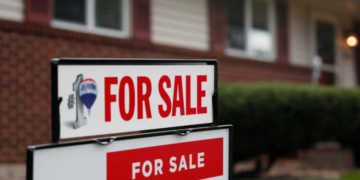March 8, 2025 Story by: Editor
When an older, low-income neighborhood undergoes transformation due to an influx of young, affluent homeowners and investors, gentrification is often underway.
Opinions on gentrification are divided—some argue it stimulates local economies, while others contend it forces long-time residents to leave as living costs rise.
“Gentrification can bring investment into areas that may not have received much attention in years past,” says Hannah Jones, Realtor.com® senior economic research analyst. “However, typically the primary beneficiaries of this investment are not the families and populations that have inhabited the neighborhood for generations, but rather the new residents.”
Regardless of one’s stance, there is a clear indicator that gentrification is taking place in a neighborhood.
Why Gray Homes Signal Gentrification
A recent Washington Post article highlighted that neighborhoods experiencing gentrification nationwide are increasingly being repainted in various shades of gray.
Their analysis of Washington, D.C., revealed that “shades of gray permeate neighborhoods where the White population has increased and the Black population has decreased.”
In San Francisco’s Mission District, longtime resident Richard Segovia, 71, has witnessed this transformation firsthand.
“All this gray—it’s so dark, it’s so gloomy, so ugly,” he expressed. “It’s like seeing creativity and art and the colors of my community disappear right in front of my eyes.”
This phenomenon extends across the country. In Colorado Springs, CO, gray has been a dominant exterior color for years, according to Andrew Fortune, a real estate agent and brokerage owner at Great Colorado Homes.
“It’s become the default for builders, house flippers, and homeowners for the past decade,” says Fortune. “It’s an easy color to choose because it feels safe, and it’s broadly appealing.”
Real estate investor Ron Myers, of Ron Buys Florida Homes, notes that outdated, bold colors often make homes harder to sell. Some buyers even walk away from purchases to avoid the hassle of repainting.
“When Myers buys older homes to renovate, he often paints them gray.
“It instantly updates the home and gives the house a fresh look,” he explains. “It also appeals to today’s buyers who want something clean and modern.”
The Rise of Gray as a Trend
To mark its 150th anniversary, Sherwin-Williams examined color trends over the decades and identified the 2010s as the era when “the graying of America” fully took hold.
Now, in the 2020s, five of the ten most popular exterior house colors are shades of gray.
“We are seeing an increased demand in particular for deeper charcoal gray tones or warmer grays,” say interior designers Teresa Boyd and Helena Finkelstein, co-owners of Olive Hill Design Company in Verona, NJ. “Gray appeals to a wide audience and often signifies a house has been recently updated or painted.”
Designer Justin M. Riordan, founder of Spade and Archer Design Agency in Portland, OR, and Seattle, likens gray’s popularity to a cultural phenomenon.
“Gray is the ‘pumpkin spice latte’ of home exteriors—it’s everywhere, it’s trendy, and whether people love it or roll their eyes at it, they’re still talking about it,” Riordan remarks.
He adds that developers favor gray because it conveys the impression of a freshly renovated home without being divisive.
“Homeowners love it because their real estate agent told them it’s what buyers want. And buyers love it because HGTV told them they should,” he explains.
Fortune shares a similar perspective:
“Many buyers don’t necessarily want gray, but they’ve been conditioned to expect it,” he says. “When almost every home on the market is some shade of gray, it becomes the norm; and anything else starts to feel different or risky.”
Weighing the Effects of Gentrification
The debate over whether gentrification benefits or harms communities has persisted for years.
“On the plus side, gentrification can result in climbing home values, putting homeowners in a strong position to sell their home for a pretty profit,” says Jones. “However, many families may not be looking to uproot and find a new place to live, and would much prefer to stay put in their neighborhood.”
Beyond rising home prices, gentrification also brings cultural and aesthetic changes, including new housing and businesses designed to appeal to incoming residents.
“These shifts may appeal to new homeowners but can make longtime residents feel out of place in their own neighborhood,” Jones notes.
This transformation can also strip a neighborhood of its unique character.
“Sometimes all of the renovated homes become homogenous and start to all look the same—especially if people are painting them in similar shades of gray,” says Cara Ameer, a real estate agent with Coldwell Banker, operating in both California and Florida. “Then a community may start to lose that charm that made it special in the first place.”
Ameer acknowledges that gentrification can bring positive changes but emphasizes the importance of balance.
“It’s a delicate line to walk—being respectful of the existing residents and history, while also working to improve the community for the better in the future,” she says.
Cities Experiencing Gentrification and the “Gray” Trend
The Washington Post article identified several cities where gray-painted homes are on the rise amid gentrification. Realtor.com economists analyzed real estate data to track these trends and their impact.
Nashville, TN
Several Nashville ZIP codes with historically high non-White populations in 2015 have since seen declining minority populations and soaring home prices.
ZIP codes 37208, 37203, 37201, 37216, 37206, and 37207 all experienced a drop of more than 10 percentage points in Black population since 2015.
During the same period, home prices in these areas surged by an average of 90.7% (from February 2017 to February 2025).
ZIP code 37201 in downtown Nashville saw the most significant increase, with median home prices climbing from $364,000 in February 2017 to $1.03 million by February 2025.
Washington, D.C.
Six Washington, D.C. ZIP codes saw their Black population share drop by more than 10 percentage points from 2015 to 2025.
Although these areas did not all experience major home price growth, the demographic shifts highlight the disproportionate effects of gentrification on minority communities.
One such ZIP code, 20002, saw a 17% decline in Black residents between 2015 and 2025, while home prices increased by 9.6% between 2017 and 2025.
San Francisco, CA
Much of San Francisco’s central gentrification likely occurred before 2015, fueled by tech wealth throughout the late 20th century and the dot-com boom.
While some central areas have since seen price declines, more affordable neighborhoods have experienced the most dramatic price growth.
For example, ZIP codes 94131, 94112, and 94124—historically less expensive parts of the city—saw home prices rise by 36.4%, 20.1%, and 13.6%, respectively, since 2017.
This growth significantly outpaces the 2.6% average price increase across central San Francisco ZIP codes from 2017 to 2025. Source: New York Post














